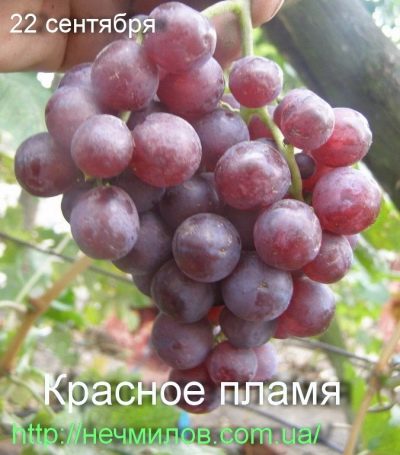
- Authors: John H. Weinberger (Fresno, California, USA)
- Appointment: dining room
- Berry color: red-purple
- Taste: harmonious
- With bones: No
- Ripening period: early middle
- Ripening period, days: 115-125
- Frost resistance, ° C: -20
- Name synonyms: Red Flame seedless, Red Flame, F32-137, Seedlis flame
- Bunch weight, g: 600-800
Red Flame grapes are an excellent product of the selection of the middle of the last century. But he is still not going to give up his positions. And therefore, many gardeners will find it interesting, even instructive, to get to know him.
Breeding history
The Red Flame was created in California, in the city of Fresno. The author of the project was John Weinberger. During the work, I had to carry out a complex crossing. The varieties Cardinal, Sultanina, Red Malaga, Tifani Akhmer, as well as Muscat of Alexandria were taken as a basis. The plant was officially allowed for use in viticultural practice in 1961.
Description
A number of synonyms have been assigned to the variety - Flame seedless, Red Flame, Red Flame seedless, F32-137. The culture is distinguished by a high level of marketability. It belongs to the category of ordinary table varieties. The proportion of fruiting shoots is from 65 to 75%, and the fruit ratio will be from 1.2 to 1.3.
Ripening period
Red Flame is the so-called early middle grape. It takes from 115 to 125 days to achieve the necessary conditions under normal conditions. Of course, with a sharp deterioration in the weather, it will take longer to reach ripeness.
Bunches
The Red Flame Brush is a cross between a cylinder and a cone. She always has two "shoulders". The grapes in bunches are moderately densely clustered. The mass of such a group is from 0.6 to 0.8 kg. Therefore, you can not be especially afraid of the peas that are so annoying to many winegrowers.
Berries
The reddish-purple fruit is seedless. They are medium in size and covered with a thin but dense skin. The main pulp is also dense and accumulates sugar abundantly. The mass of an oval or close to oval berry will average 4.2 g. Its dimensions are 2.2x1.8 cm.
Taste
For grapes, Red Flame typically has a harmonious taste sensation. There is a characteristic crunching sound. There are no gastronomic problems with this culture. The skin on the grapes is not felt when eaten.
Yield
The fertility of this culture is quite high. Up to 80% of the branches can bear fruit. The vines are tall or even very tall. Unfortunately, it is extremely difficult to find accurate numerical data on the amount of the crop. All available sources are limited to general words.


Growing features
Red Flame Cuttings root very well. The compatibility with various rootstocks is also quite decent. The basic requirements for planting and care do not differ from those that apply to the culture of ordinary grapes.The plant is light-requiring and needs fertile soil. A high level of soil water, as well as stagnant fluid, are contraindicated.
Landing
You can plant such a culture in autumn and spring. At this point, you need to take two or three year old seedlings. The size of the landing hole is 500x500x600 mm. There should be a distance of at least 1 m between the bushes.The optimal soil mixture consists of:
- 3 shares of humus;
- 1 part peat;
- 2 parts sand.

Pollination
Red Flame bushes are bisexual, so they can be grown even in an area where no other grapes grow. No special attraction of insects is required.
Pruning
The normalization of the landings must be carried out without fail. On one bush, 20-30 shoots are left. You need to cut the bush for 30-40 eyes. Any gardener can choose a more accurate indicator on his own.



Frost resistance and the need for shelter
The variety retains its qualities perfectly at -20 degrees. And yet, despite this, it is hardly possible to do without a protective shelter. Most often, they use proven covering materials such as spunbond. Shelter with spruce branches is not recommended.

Diseases and pests
The variety is susceptible to pathological fungi. It is imperative to defend against their attacks. Anthracnose, mildew, phylloxera are also dangerous. Of insects, the plant is threatened by the leafworm, grape itch, and the common spider mite.

If a grape is exposed to any disease or insect, this always affects its appearance.
Storage
You can save the crop up to 10 weeks after harvest. It is best to keep the harvested fruit in the refrigerator. If you want to keep the grapes longer, you will have to choose between:
- raisins;
- juice;
- homemade wine.











































































